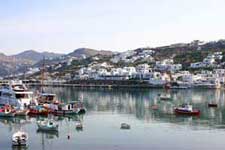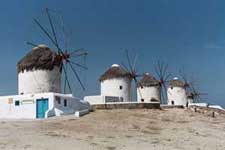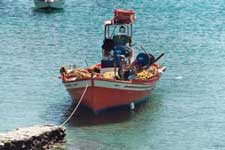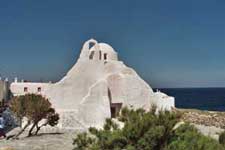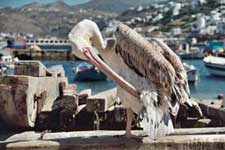Periphery: South Aegean
Prefecture: Cyclades
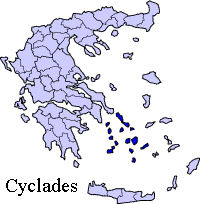 |
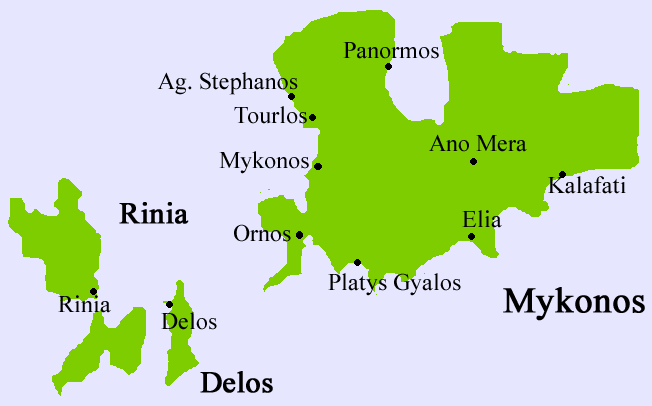 |
Mykonos (English: /ˈmiːkənɒs/, Greek: Μύκονος [ˈmikonos]) is a Greek island, part of the Cyclades, lying between Tinos, Syros, Paros and Naxos. The island spans an area of 85.5 km2 (33 sq mi) and rises to an elevation of 341 m (1,119 ft) at its highest point. There are 9,320 inhabitants (2001) most of whom live in the largest town, Mykonos, also known as Chora (i.e. the Town in Greek, a common denomination in Greece when the name of the island itself is the same as the name of the principal town), which lies on the west coast. Mykonos attracts a number of European vacationers.[1][2][3][4]
History
Archaeological finds indicate that the Ionians settled on Mykonos in the early part of the 11th century BCE. Recent discoveries have uncovered remnants in Ftelia beach from the Neolithic Kares tribe dating back to as far as 3000 BC.[CN]
In ancient times, Mykonos, due to its proximity to the then highly populated island of Delos (situated about 2 kilometres (1.2 mi) away), became very important as a supply island and possibly as a getaway location for Delian citizens.
Since 1900
The island was once very poor. The people tried to survive on fishing and stock breeding. Ship construction was a major industry. Tourism has dominated the economy since the 1950s.[5]
Mythology
In Greek mythology Mykonos was the location of the battle between Zeus and the Titans, and the island was named in honor of Apollo's grandson Mykons.[
Geography
Panoramic view of Chora port
The old port of Chora
The island spans an area of 85.5 km2 (33 sq mi) and rises to an elevation of 341 m (1,119 ft) at its highest point.
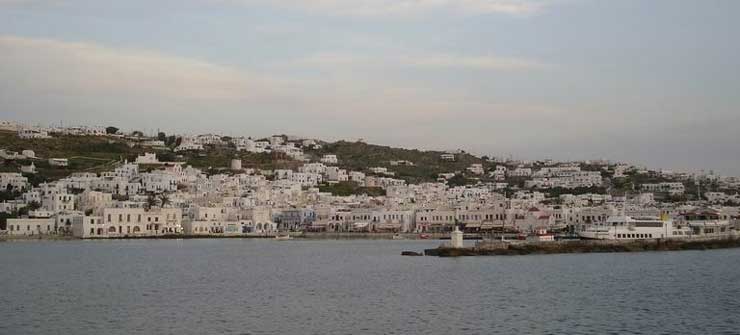

Panorama Image of Mykonos town at sunset looking West [Source]
Geology
The island is composed primarily of granite.
Government
Elias Beach
Mikri Venetia (Little Venice)
Mykonos is a separate peripheral unit of the South Aegean Periphery, and the only municipality of the peripheral unit.[6] As a part of the 2011 Kallikratis government reform, the peripheral unit Mykonos was created out of the former Cyclades Prefecture. The municipality, unchanged at the Kallikratis reform, also includes the islands Delos, Rineia and several uninhabited islets. The total area of the municipality is 105.2 km2 (41 sq mi)
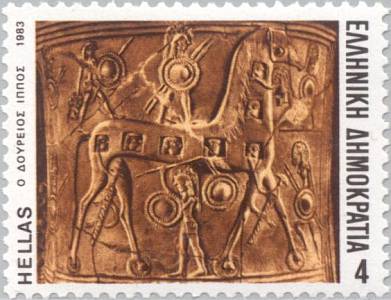
The Trojan horse, Burial Pithos, c. 670 BC, Archaeological Museum of Mykonos, Greece

Woman From The Island Of Mykonos
Workshop of Jean Baptiste Vanmour
It has little natural fresh water and relies on the desalination of sea water in order to meet the needs of its population.
Demographics
There are 9,320 inhabitants (2001) most of whom live in the largest town, Mykonos, also known as Chora (i.e. the Town in Greek, a common denomination in Greece when the name of the island itself is the same as the name of the principal town).
Year Municipality population
1971 3,863
1981 5,530
1991 6,179
2001 9,320
|
|
|
|
|
|
|
|
|
Economy
Tourism
Since the 1960s,[7] the island has been a tourist destination for gay people.[8]
Landmarks
Church of Paraportiani, Mykonos.
Chora, Mykonos.
Street in Mykonos.
Petros the Pelican - An old celebrity of the town's waterfront, "Petros" has been the official mascot of Mykonos for over 50 years.
Mykonos windmills - From as early as the 16th century, they are one of the most recognized landmarks of Mykonos.
Little Venice - Here the buildings have been constructed right on the sea's edge with their balconies overhanging the water.
Paraportiani - One of the most famous architectural structures in Greece. Its name means inner or secondary door which it was to the Medieval stone walls which encircled the area.
Archaeological Museum - Houses marble sculptures, ceramics and jewellery recovered from the islands of Delos, Renia and Mykonos.
Aegean Maritime Museum - Displays models of a collection of ships from the pre-Minoan period through to the 19th century and nautical and ancient artifacts related to the history of shipping on Mykonos.
Transportation
Mykonos Island National Airport is an international airport.
Cruise ships visit.
Notable people
Ioannis Gryparis, diplomat and politician

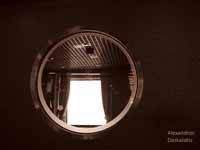

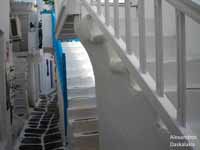
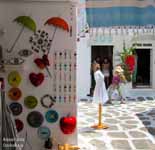
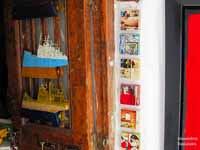


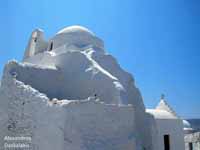
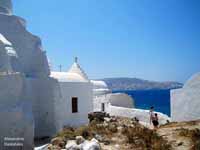
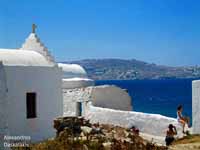
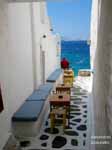
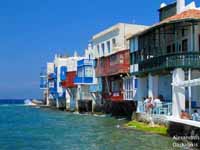



Municipality Mykonos(Seat: Μύκονος, η) |
|---|
| Municipal Community Ano Mera |
| Ano Mera (Άνω Μερά Μυκόνου, η) |
| Kalafati (Καλαφάτη Μυκόνου, η) |
| Ktapodia (Κταπόδια Μυκόνου, τα (νησίδα)) |
| Tragonisi (Τραγονήσιο Μυκόνου, το (νησίδα)) |
| Municipal Community Mykonioi |
| Agios Ioannis Diakoftis (Άγιος Ιωάννης Διακόφτης Μυκόνου, ο |
| Agios Stefanos (Άγιος Στέφανος Μυκόνου, ο) |
| Delos (Δήλος Μυκόνου, η (νησίδα)) |
| Kavouras (Κάβουρας Μυκόνου, ο (νησίδα)) |
| Klouvas (Κλουβάς Μυκόνου, ο) |
| Krommydi (Κρομμύδι Μυκόνου, το (νησίδα)) |
| Marmaronisi (Μαρμαρονήσιο Μυκόνου, το (νησίδα)) |
| Baos (Μπάος Μυκόνου, ο (επί της νήσου Αγίου Γεωργίου)) |
| Mykonos (Μύκονος, η) |
| Ornos (Ορνός Μυκόνου, ο) |
| Platys Gialos (Πλατύς Γιαλός Μυκόνου, ο) |
| Plintri (Πλιντρί Μυκόνου, το) |
| Rineia ( Ρήνεια Μυκόνου, η (νησίδα)) |
| Sfontili (Σφοντήλι Μυκόνου, το (νησίδα)) |
| Tourlos (Τούρλος Μυκόνου, ο) |
| Faros Armenistis (Φάρος Αρμενιστής Μυκόνου, ο) |
| Psarrou (Ψαρρού Μυκόνου, η) |
See also
Communities of the Cyclades
Mykonos vase
List of traditional Greek place names[9]
References
^ Tom Masters, Europe on a shoestring, 2008
^ Duncan Garwood, Mediterranean Europe, 2009
^ Lloyd E. Hudman, Richard H. Jackson, Geography of travel and tourism, 2003
^ Harry Coccossis, Alexandra Mexa, The challenge of tourism carrying capacity assessment: theory and practice, 2004
^ http://www.in2greece.com/english/places/summer/islands/mykonos.htm
^ Kallikratis reform law textPDF
^ Christian Göttner: „Komisch und krank, geil und traurig“. Interview mit Ralf König. (http://www.subway.de/magazin/1999/07koenig.shtml).
^ Porter, Darwin; Mark Baker, Danforth Prince, George McDonald, Sherry Marker, Ryan James. Frommer's Europe. Wiley and Sons. pp. 27. ISBN 0-06-621330-4.
^ Article about Mykonos
Greece :
A - B - C - D - E - F - G - H - I - J - K - L - M -
N - O - P - Q - R - S - T - U - V - W - X - Y - Z
Retrieved from "http://en.wikipedia.org/"
All text is available under the terms of the GNU Free Documentation License
| Ancient Greece
Science, Technology , Medicine , Warfare, , Biographies , Life , Cities/Places/Maps , Arts , Literature , Philosophy ,Olympics, Mythology , History , Images Medieval Greece / Byzantine Empire Science, Technology, Arts, , Warfare , Literature, Biographies, Icons, History Modern Greece Cities, Islands, Regions, Fauna/Flora ,Biographies , History , Warfare, Science/Technology, Literature, Music , Arts , Film/Actors , Sport , Fashion --- |


